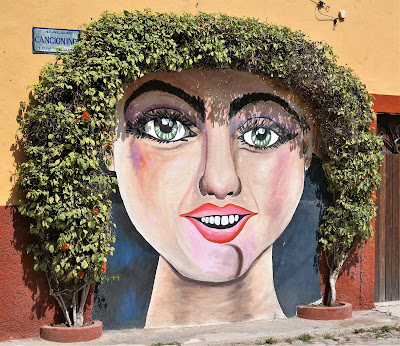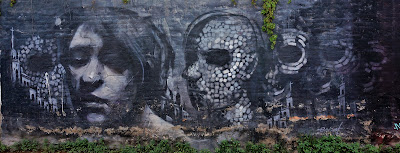Some people hate it. Others love it.
And you can tell by the words they choose to describe the art form where they stand on that divide.
The haters call it graffiti. The lovers call it street art. Or urban muralism. Or, with a nod at reconciliation, post-graffiti art.
The rift tends to be generational. Young people find it cool. Older people are prone to call it vandalism. If that is true, even though I fall easily into the senior citizen camp, I am a traitor to my race. I like the stuff.
The street art in San Miguel de Allende started as a problem. Like many cities, bored teens (almost exclusively boys) started tagging walls in town. It was rather minor, but when the UNESCO-designated central was tattooed with narcissistic signatures, the authorities got worried.
At about that same time, a resident American artist, Colleen Sorenson, saw two very talented young artists arrested just outside of her neighborhood, Guadalupe, for painting what she thought was a very interesting piece of art. Enraged that artists were being arrested for merely painting, she devised a plan.
She knew street art would never be appropriate in the central area with its historical heritage. But her neighborhood had lots of blank walls that had the possibility of being enlivened with murals. And, if the walls were made available for murals, the taggers might be drawn to painting something more formal.
So, she approached the city government. After surviving the usual bureaucratic struggle arguing that the murals would be a tourist magnet for the Guadalupe neighborhood, she had her project.
But there were some restrictions:
- No painting could be done without the permission of the property owners.
- None of the murals could be visible from the historical district.
- The murals could not be advertisements for commercial establishments.
- Political content was prohibited.
That was 2013. Since then, there have been additional fiestas and more walls painted. Other walls have been painted, as well,without the need of a fiesta.
Word has spread world-wide of this project. Even though Mexico and San Miguel de Allende were late comers in urban muralism (South America has been a leader), artists from Canada, The States, Brazil, Japan, France, Costa Rica, Switzerland, Kenya, Spain, and other countries breeze through town and spend a few days creating some outstanding art -- and some not so outstanding.
Urban muralists know they work in a transitory art form. The sun and moisture will destroy most of the murals within a year or two, what the artists bittersweetly call "the life of a wall." Murals painted on metal, stucco, or brick will last longer.
But, eventually they will all be replaced by new mural painted either by local or foreign artists. Colleen spends a good portion of her days enticing home owners to volunteer their walls for a project that has brought new life to Guadalupe.
The brief tenure of the murals remind us of our own eventual deaths. And, just like our lives, they provide joy to others while we live.
Let's take a look at some of the murals. I will not add much commentary. That you can provide for yourself.
Remember the rule about no political content? This mural rather shatters the rule. The Communist Manifesto is hardly neutral politically.
And the ban on commercial content? Gone.
But life is not all politics (fortunately) or commerce. Sometimes, it is pure beauty.
Or just pure art.
With a little Magritte thrown in for flavor.
Most of the pieces avoid rank sentimentality, but not all. The left side of this mural is quite good. The right side looks like something off of a Mexican Mother's Day card.
And some are merely whimsical.
Or sublimely surreal. Dali would appreciate the rhinoceros.
Decay creates its own art form. Colleen informed us that photographers love to shoot details like this. So, I did.
This dragon has a fascinating illusion of illumination.
Comic book art with an heroic twist. Notice the post-production pixelization on the woman. My mother would approve.
Or this life-morphing piece.
I included this mural because of its technique. The artist projected an outline and then used aerosol paint to complete it.
This piece is nicknamed "road kill," I call it "hello, kitty."
Young artist from Queretaro and a Canadian friend created this mural. It depicts The Beast -- the train that brings children refugees through Mexico to the United States from Central America. The children are represented as fleas on dogs acting as the train. The mural was painted before The Beast was known internationally.
Everyone's favorite is this mural. Painted by the Mexico City artist Sego. It honors the leader of the farmers who stood up to the cartel in Michocan, and who was jailed by the federal government for his troubles. Painted on a metal door with aerosol.
If the goal of the Muros en Blanco project was to turn the Guadalupe neighborhood into something new, it worked. It is always hard to say if the murals drew new businesses to the neighborhood or if the new businesses reflect the spirit of the murals.
Either way, Guadalupe is becoming known for its restaurants, its emerging art galleries, and a boom in new construction.
My friends Todd and Shannon introduced me to the murals as we drove by them a few years ago. I never followed up on foot. I should have.
Even for those of you who see these murals as graffiti, let me suggest that you should come see them in person. You just may switch to the other side of the divide.




























No comments:
Post a Comment